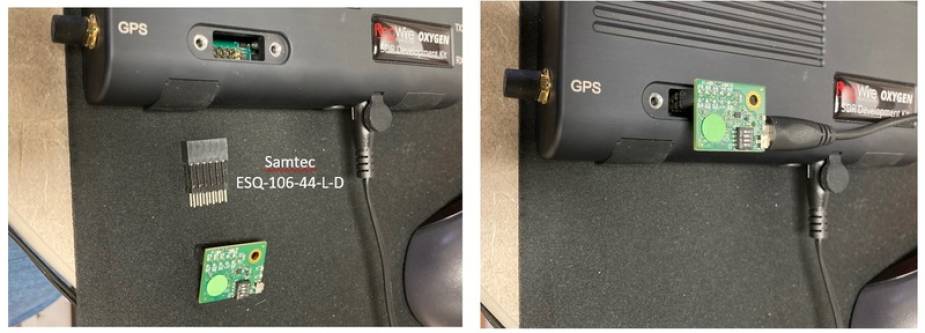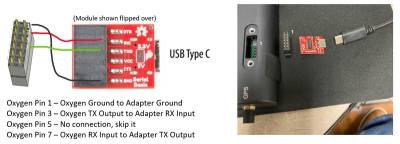Linux Console Port Access for Oxygen
There are 3 options for accessing the console port of the RWT Oxygen SDr supported by RWT. There are other untested options also available.
Samtec Extender
RWT recommends the use of the SAMTEC ESQ-106-44-L-D PMOD extender to make access to the debugging pins easier.
Trenz Electronics XMOD FTDI JTAG Adapter TE0790-03
Due to Covid related shortages, this part is difficult to acquire and has a long lead time. The Trenz Electronics XMOD FTDI JTAG, Xilinx compatible Adapter is the preferred way to access the console port. This also provides access for the FPGA JTAG. To connect the Trenz TE0790-03 to the RWT Oxygen, remove the 2 screws holding the cover over the debug pins from the top of the case. Insert the SAMTEC Extender, ESQ-106-44-L-D.
It is important to have switches 1 and 4 on, and switches 2 and 3 off on the Trenz TE0790-03.
When using the Trenz TE0790-03 the first UART device is the FPGA JTAG, the second UART device is the console port for the ARM processors.
It is recommended to use a serial port communications software product like putty, minicom, or picocom to connect to the console port. The baud rate is 115200.
For more information on the module see the Trenz website.
Serial UART Connections
The Oxygen UART uses a 3.3V connection operating at 115200 baud rate: Pin 1 is the pin closest to the edge of the case, farthest from the “GPS” label.
The pinout for the serial UART connection on the RWT Oxygen SDR is:
-
Oxygen Pin 1 – Oxygen Ground to Adapter Ground
-
Oxygen Pin 3 – Oxygen TX needs to connect to the TX on a USB to serial device
-
Oxygen Pin 5 – No connection, skip it
-
Oxygen Pin 7 – Oxygen RX, needs to connect to the TX on a USB to serial device
Connecting a Sparkfun Serial Basic Breakout –CH340G – DEV-14050
This module provides serial to USB 2.0 conversion utilizing a USB-micro port to connect the Oxygen unit boot terminal to a host computer. Connections are as follows:
-
Oxygen Pin 1 – Oxygen Ground to Adapter Ground
-
Oxygen Pin 3 – Oxygen TX Output to Adapter RX Input
-
Oxygen Pin 5 – No connection, skip it
-
Oxygen Pin 7 – Oxygen RX Input to Adapter TX Output

On the SparkFun module there is a voltage mode jumper labeled 5V and 3.3V. The default voltage setting is 3.3V. Leave this module in the default 3.3V position/mode.
Use caution when plugging the Samtec extension connector into the Oxygen unit. Be sure that all connections are made. Verify that the Samtec extension connector and the internal Oxygen connector are aligned and that no pins have been missed.
At this point, with these connections in place, the USB cable can be attached to the Sparkfun adapter and to the host PC. The serial port will then enumerate and will show up in your host PC’s system. Use your normal procedure(s) for connecting your computer to a comm port, baud rate is 115200 baud.
Connecting a SparkFun Serial Basic Breakout –CH340C and USB-C, DEV-15096
This module provides serial to USB 2.0 conversion utilizing a USB-C port to connect the Oxygen unit boot terminal to a host computer. Connections are as follows:
-
Oxygen Pin 1 – Oxygen Ground to Adapter Ground
-
Oxygen Pin 3 – Oxygen TX Output to Adapter RX Input
-
Oxygen Pin 5 – No connection, skip it
-
Oxygen Pin 7 – Oxygen RX Input to Adapter TX Output

On the SparkFun module there is a voltage mode jumper labeled 5V and 3.3V. The default voltage setting is 3.3V. Leave this module in this default 3.3V position/mode.
Use caution when plugging in the Samtec extension connector into the Oxygen unit. Be sure that all connections are made. Verify that the Samtec extension connector and the internal Oxygen connector are aligned and that no pins have been missed.
At this point, with these three connections in place, the USB cable can be attached to the Sparkfun adapter and to the host PC. The serial port will then enumerate and will show up in your host PC’s system. Use your normal procedure(s) for connecting your computer to a comm port, baud rate is 115200 baud.
JTAG Connections
-
Oxygen Pin 2 – Ground
-
Oxygen Pin 4 – TCK_B
-
Oxygen Pin 6 – JTAG VCC
-
Oxygen Pin 8 – TDO_B
-
Oxygen Pin 10 – TDI_B
-
Oxygen Pin 12 – TMS_B
